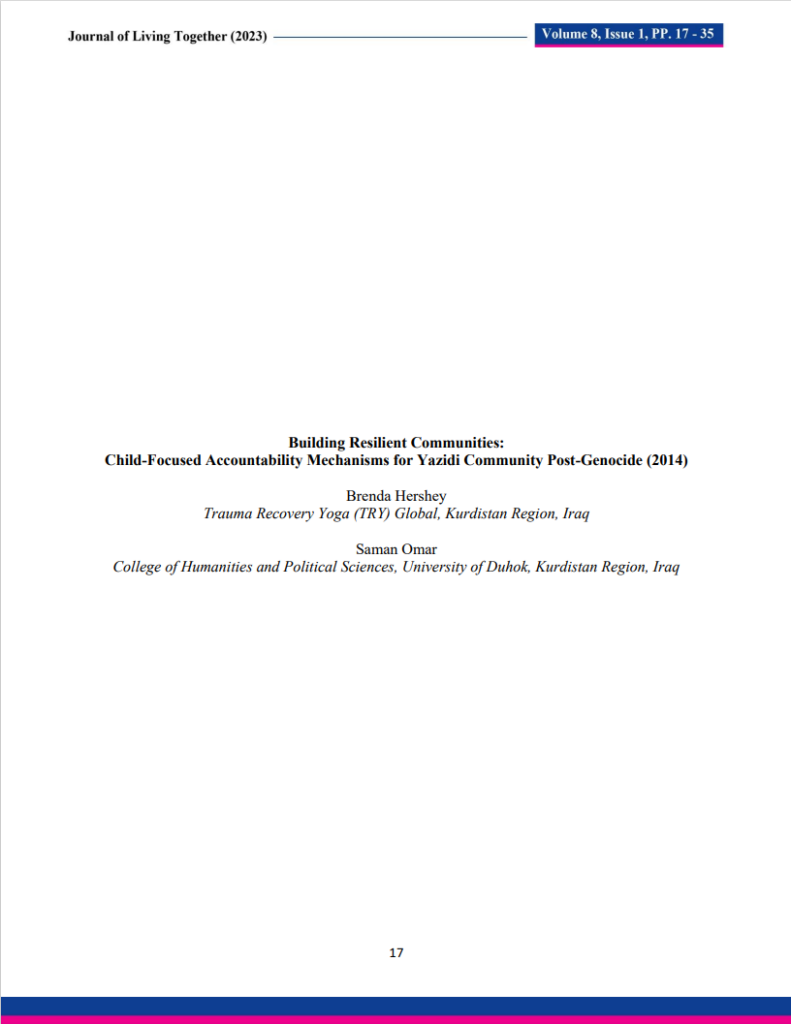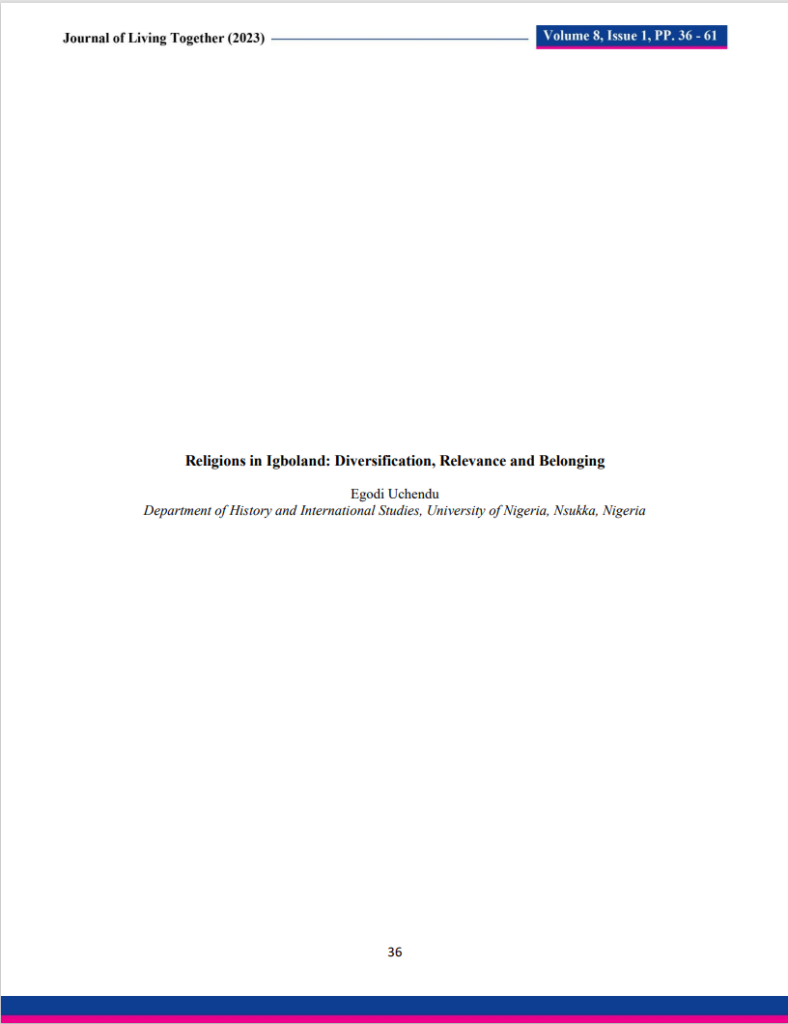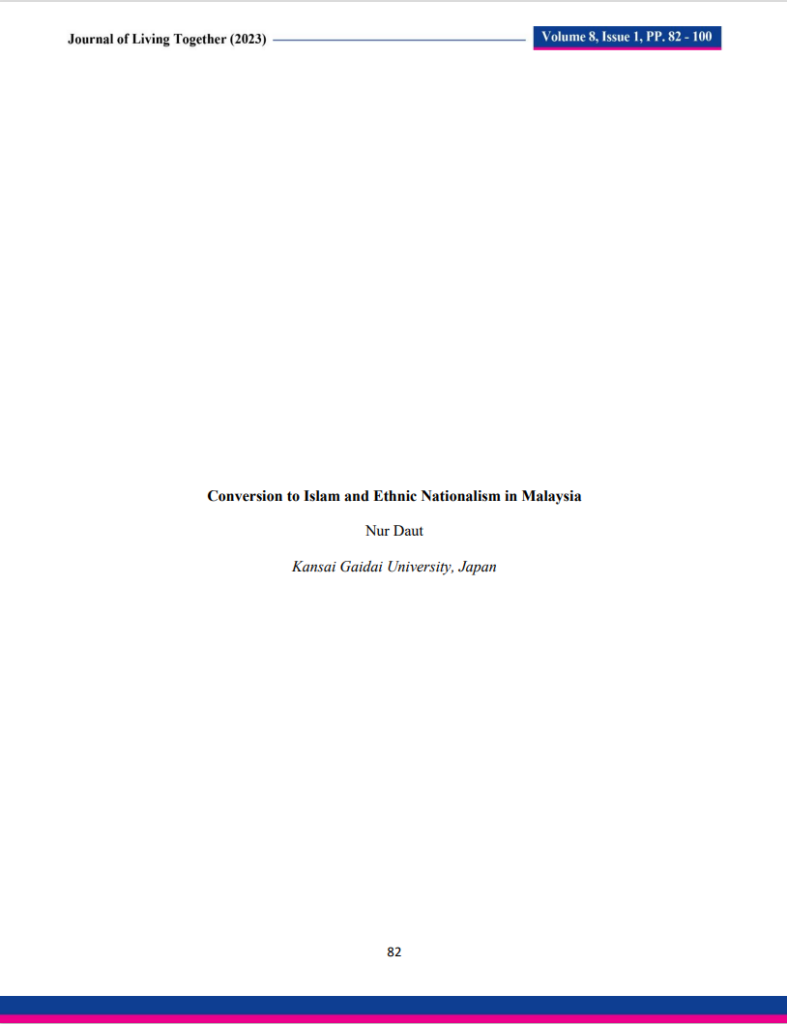Mosques’ Vital Role in Preventing Radicalization: Strategies and Impact

Abstract:
There is social and academic concern about the measures that should be taken to prevent radicalization and to rehabilitate individuals convicted of terrorist offences into society. Good evaluative studies on counter-radicalization are still lacking. Nevertheless, communities can play an essential role in preventing radicalization and providing support to the affected community members. Being aware of such influence there are mosques in Europe that are playing an active role in fighting this phenomenon. They are a fundamental actor in the socialization of individuals and have an influence on the Muslim community. Besides, religious support and spiritual guidance are included in programs whose efforts are dedicated to disengaging individuals from terrorism. The aim of this paper is to analyze the role of mosques in preventing radicalization and rehabilitating radicalized individuals in different European countries. Specifically, this study focuses on the cases of Spain and Denmark.
Download The Article
Suggested Citation:
García, M. I. G. (2023). Mosques’ Vital Role in Preventing Radicalization: Strategies and Impact. Journal of Living Together, 8(1), 73-81.
Article Information:
Title = {Mosques’ Vital Role in Preventing Radicalization: Strategies and Impact}
Author = {María Isabel García García}
Url = {https://icermediation.org/?p=69211}
ISSN = {2373-6615 (Print); 2373-6631 (Online)}
Year = {2023}
Date = {2023-11-18}
Journal = {Journal of Living Together}
Volume = {8}
Number = {1}
Pages = {73-81}
Publisher = {International Center for Ethno-Religious Mediation (ICERMediation)}
Address = {White Plains, New York}
Edition = {2023}.
Introduction
There is social and academic concern about the measures that should be taken to prevent radicalization and to rehabilitate individuals convicted of terrorist offences into society. Nevertheless, according to several academics there is a lack of good evaluative research about counter-radicalization (Silke & Veldhuis, 2017; Koheler & Verena, 2019), which refers to the anticipatory answer that governments implement with the purpose of preventing individuals from committing crimes of political violence. In that sense, the United Nations Counter-Terrorism Implementation Task Force (CTITF) provides a definition of counter-radicalization:
Policies and programs aimed at addressing some of the conditions that may propel some individuals down the path to terrorism. It is used broadly to refer to a package of social, political, legal, educational, and economic programs specifically designed to deter disaffected (and possibly already radicalized) individuals from crossing the line and becoming terrorists. (UN CTITF, 2008)
The importance of Muslim communities is growing in programs focused on prevention of radicalization and more specifically local mosques. They usually have a space of trust and influence to counter the extremist narrative and the abilities to detect if someone is in the process of radicalization. For instance, the Dutch plan called ‘The Netherland Comprehensive Action Programme to Combat Jihadism’ provides for close cooperation with the Muslim community, seeing Imams and mosque boards as allies in the battle against extremism. Other European countries such as UK, Norway or Finland have also incorporated this initiative into their programs. One of the most popular is the German initiative called ‘The Advice Centre Hesse’. It promotes a bunch of measures, including increase (religious) tolerance of different worldviews, as well as early detection, prevention, and reversal of radicalization processes (The Radicalization Awareness Network [RAN], 2019). It has a series of services to carry out among which is to offer advice to parents and mosque congregations.
In this context, the aim of this article is to analyze the role of mosques in preventing radicalization and rehabilitating radicalized individuals in different European countries, more specifically in the cases of Spain and Denmark. In the aftermath of the 11-S attacks, the rhetoric of political leaders and security agencies focused on the threat of Islamic radicalization which could lead to violent acts. Preventing such events from occurring is a major concern of institutions and academia.
It is noted that this is an exploratory study that seeks to contribute to shed light on the role of mosques in preventing radicalization and rehabilitating individuals. At this stage, there is not a database or index that measures the level of radicalization, or the number of people affected. This article will focus on exposing the initiatives in Spain and Denmark to combat this phenomenon through some case experiences.
Vulnerability to Radicalization
The process of radicalization is a multifaceted and gradual one, wherein an individual or group adopts a radical ideology or belief system that justifies, employs, or tolerates violent means, such as acts of terrorism, to achieve a particular political or ideological objective. Several authors (Kruglanski et al., 2019) point out that there are personal factors that make a person more vulnerable to be extremist. Some scholars argue that identity is a key driving factor to understand why this process occurs (Hoyle et al., 2015) especially in teenagers; as at an early age, maturity has not been reached and it could be easy for them to suffer from manipulation. As Saltman and Smith point out in the article, ‘Till Martyrdom do us part, Gender and the ISIS Phenomenon’, “the added factor of being a part of a minority ethnicity and/or religion tends to naturally embed a sense of otherness” (Salman & Smith, 2015). Additionally, Sociologist Donatella Della Porta argues that social exclusion, marginalization, and lack of economic opportunities can be factors that influence the radicalization of individuals (Della Porta, 2015). More studies support this idea. For instance, an article published in the journal ‘Neuroimaging’ in 2018 noticed that social exclusion increases the likelihood of engaging in extremist behavior (Pretus et al., 2018).
There is no single factor that explains why the process of radicalization occurs. Nevertheless, the feelings of loneliness or humiliation and the consequent need for revenge have been proposed by some authors as relevant mechanisms that can trigger the process of radicalization (Merari et al., 2010). In this way, the existence of a network that provides social support can mitigate this kind of feelings. Mosques have huge potential to prevent radicalization as they are a place of social support. They are the emblem of Islamic society but also a place of expression of a collective identity and the space where the Muslim community is socially structured (Moreras, 2014).
In these spaces people gather to practice religion and interact with people with whom they share common interests. It is one of the most popular recruiting environments as these characteristics surrounding the mosque make it a place of trust, a place of recreation with those they consider to be their peers. It is in these spaces, moreover, that people come to seek solace in unfavorable life situations and, therefore, where they are more vulnerable. That is the reason extremists try to exploit mosques as a place in which they recruit followers (Neumann & Rogers, 2007). In the case of Spain, for instance, between 1995 and 2012, it has been recorded that 46.1 percent of individuals arrested for jihadist terrorism-related activities were radicalized in mosques or other places of worship (Reinares et al., 2019).
It is true that there are other spaces of religious influence outside the mosque that are attractive or more popular for the new generations, but there are authority figures in the mosques that maintain great legitimacy. The Imam is the person who leads the prayer and offers sermons to the community in the mosque. He transmits Islamic teaching, values, and beliefs in his sermon, which shapes the thinking patterns of individuals (Ammad-ul-Haque, 2021). This position makes the Imam have a vast impact on the whole community since he commands respect. From the preceding discussion, it is evident that this sacred space contributes to the social, educational, and spiritual aspects of the community and could be a key element in counter-radicalization initiatives.
Mosques in the Basque Country: Building Bonds of Trust
The Basque Country is an autonomous community located in the north of Spain. This area, with just over two million inhabitants, has never suffered a jihadist terrorist attack, but it is true to say that from 2012 to 2017 there have been 13 arrests in the Basque Country related to jihadism, mainly for indoctrination and glorification of terrorism[1]. It is a small number compared to the national average, which during those years reached 243 arrests (Stadista, 2017). However, the Basque government has launched an initiative aimed to collaborate with the Islamic community and mosques in order to prevent violent radicalization.
This plan is known as ‘Comisión Asesora ADOS’ and it was created in 2018. Its aim was to lay the foundations to start a collaboration between the Islamic community in the Basque Country and other institutions. Thus, this plan is a strategy, which looks for participation, cooperation, and advisement for the public policies of the Basque government and Basque institutions in their relations with the Islamic communities. It is difficult to know the exact number of mosques in the Basque Country, but around 54,000 Muslims live in the area, of which 43,043 have foreign origin, which means 2.4 percent of the total population of the Basque Country. The majority Islamic immigrant community in Spain comes from Morocco, which began to have a small presence in the country in the 1960s due to the economic boom.
Comisión Asesora ADOS works on the agreement of recognition and promotion of a Basque Islam base on toleration and opposed to any legitimization of terrorism under religious pretext. In this sense, the mission of ADOS is to promote, consolidate and integrate coexistence of Islamic communities in Basque society as a part of it. Since it was established, a total of 9 meetings have been held, 4 each year. As part of this commitment to promote interaction and cooperation between Islamic communities and the different realities that make up Basque society, a project on diversity and coexistence among young people has been set up.
Moreover, a series of events have been held since the signing of this plan. Some of these events were the celebration of an International Seminar on Prevention of Violent Radicalization; a meeting of the President of the Basque Country with 29 Imams of Euskadi and, finally, a meeting to present the results of the report on the present reality and prospects for coexistence of Islamic communities in Basque society and on the concerns and demands of Muslim citizenship in Euskadi. These activities aimed at achieving greater coexistence and cooperation between the different Islamic communities and institutions, which is a way to reduce the level of mistrust and social invisibility.
In addition to this, the Basque government has launched another initiative to promote bonds of trust with mosques. These two institutions have collaborated in the creation of a document which has been distributed in mosques in order to reduce the phenomenon of violent radicalization. Also, the Basque police, known as the Ertzaintza, are participating in a series of talks in mosques. Some of the topics that have been discussed in these meetings have been awareness of the importance of the mosque in preventing the phenomenon of violent radicalization or the practical training of Imams to detect individuals who have initiated this process. Likewise, deradicalization programs are presented in which Imams’ collaboration and help is provided to families who do not have the necessary tools to face this situation. According to police officers, the creation of bonds of trust between members of the Muslim community and the rest of the institutions is essential to combat this phenomenon. “We also work with Imams. Their role is fundamental in redirecting individuals and taking away certain ideas of head (Echaniz, 2017).
Denmark’s Countering Violent Extremism (CVE): From Preventing to Rehabilitation of Individuals from Extremism
Since the Danish ‘Cartoon Crisis’ in 2005, that triggered an important social tension in the country and abroad, authorities in the country have been warned of a possible terrorist attack. That year the Danish newspaper Jyllands-Posten published 12 images showing Prophet Muhammad, one with a bomb in his turban. Since then, there was one successful attack in 2015 when two people died and five others were injured in two shootings separated by hours in a cultural center and near a synagogue in Copenhagen. Four years later, two Swedish men detonated an explosive at Denmark’s central tax authority. Since the appearance of ISIS in 2012, an estimated one hundred and fifty Danish citizens have travelled to Syria or Iraq, at least half of whom have returned to Denmark (Parker & Lindekilde, 2020).
In response to these events, Denmark authorities have developed strategies on countering radicalization. One of the most important strategies is “The Aarhus model: Prevention of Radicalization and Discrimination in Aarhus”, which comprises programs for both early prevention and exit processes. The city of Aarhus is the second largest city of the country and has a population of about 250,000, of which almost 16 percent are immigrants (Stadistic Denmark, 2022). The first wave of immigrants with a Muslim family background arrived in Aarhus in the 1960s and they came from Turkey. Currently, the Muslim community in the city is also composed by Lebanon, Somalia, Iraq, Iran, and Afghanistan descendants.
The Aarhus model dates back to 2007 and is considered an innovative and successful strategy in the field of counter-radicalization. The roots of this project are based on a solid initiative launched in 1990 in Aarhus city which was extended to all municipalities in Denmark. This original project emphasizes community involvement and engagement, and it involves collaboration between local authorities, and civil society organizations. Following the good results of this initiative Denmark launched the anti-radicalization program, which is also organized around the principles of interdisciplinary collaboration between institutions and inclusion.
The Aarhus model regards radicalization in the same way as any other crime prevention work. It is about criminal conduct and activism outside the law. Therefore, the anti-radicalization project is organized as collaboration between schools, social authorities, and police aimed at crime prevention (Bertelsen, 2015). The strategy consists of an intervention at two levels: it addresses the general population as well as individuals, and approaches each case based on social psychology evidence and principles. Regarding general population, the intervention consists of raising awareness of professionals and the public and short collaboration with local communities, which involves respectful and assertive dialogue with mosques, cultural associations, and other major players in local communities (RAND, 2019).
In fact, the Aarhus team is in continuous open dialogue with different Muslim communities, organizations, and mosques in the city. There is a significant role for the figure of a mentor, who provides advice, guidance, help finding paths of inclusion and discusses existential, political, and religious questions of life (Johansen, 2020). For instance, some individuals who showed signs of radicalization explain the support they found in that figure. That is the case of Mohammed, a young Dane who was an Al-Qaeda (AQ) sympathizer.
He had been self-radicalized by watching AQ ideologue Anwar Al-Awlaki’s and he started to fraternize with extremists. In 2014, Mohammed’s family called a hotline after he vowed to travel to Syria. Aarhus authorities then arranged for a mentor who engaged in a debate on the meaning of jihad with him. In subsequent meetings, the mentor introduced a more rational worldview to Mohammed that allowed him to help other Muslim Danes by being a moderate role model. Since then, Mohammed has continued with his studies and also helped his mentor dissuade students and individuals from joining extremist circles. (Saiful & Hassan, 2019)
This support and the transmission of the real sense of religion without manipulation reflect the great impact both can have on individuals. This can also work in a negative way when Imams use sacred spaces to transmit an ideology that has nothing to do with religion. For instance, the Grimhøj mosque in the city of Aarhus is a place that has shown sympathy for ISIS. In September 2014, the mosque’s leadership declared its support to the terrorist group. At least twenty-two of the more than one hundred Danish foreign fighters who have travelled to Syria and Iraq had previously worshipped at that mosque. This number reveals the influence that the Imam could have on people who came to the mosque looking for religious orientation or sociability. Two years later that Imam also called for women adulterers to be stoned to death (The Local, 2016).
Regarding rehabilitation for returning foreign fighters Aarhus model offers medical treatment for war wounds and the ones who suffer from psychological trauma. It also helps individuals to find a job or further their education. Once the foreign fighters return to Denmark, they are interviewed by the police with the aim of determining if they have committed crimes since the first priority is to make sure they are prosecuted. At this stage, the Aarhus team does not combat the ideology of individuals. On the contrary, they respect their beliefs as long as their acts adhere to the Danish Penal Code, an idea that Aarhus team tries to highlight in the meetings the Arhus team has with foreign fighters. Also, they offer alternatives such as helping Syrian and Iraqi refugees in order to reduce their appeal for joining a terrorist group (Saiful & Hassan, 2019).
The approach of not combating the ideology of individuals is remarkable according to the social psychologist Arie Kruglanski. This expert on the phenomenon of radicalization points out that tolerance and good treatment could open a possible window into rethinking and re-evaluating programs of rehabilitation (Rosi, 2016). Radicalized individuals have a polarized view of a conflict. They consider anyone who does not share their ideology to be the enemy. Therefore, when they are treated with respect, it may come as a shock to them. That kind of shock changes people’s minds and makes them believe that they were wrong about their society that they perceived as their enemy (Rosi, 2016).
Conclusion
The prevention of radicalization and the rehabilitation of individuals are a complex issue that still needs extensive study. Although there is still few research, throughout the article several examples of the role that mosques could play in preventing radicalization have been shown. Worship places are one of the obvious locations to seek clarification of terrorist attacks. That is why it is necessary to create bonds of trust between institutions and involve mosques in the fight against jihadist terrorism. Western public institutions and mosques must work together to improve the attraction of these spaces for young people, as well as in the area of social legitimation and women inclusion. Strengthening these mechanisms would have an impact on other recruitment spaces.
The Aarhus model has provided an important approach to preventing radicalization and rehabilitating individuals. Programs focused on this phenomenon should address the threats that trigger the process of radicalization. Over time, it is crucial to tackle exclusionary factors and other menaces that undermine the essential foundations of life. It would be positive to incorporate religious authorities, local leaders, or people who have gone through the same circumstances into this type of treatment so that they can not only guide these individuals but also combat extremist doctrine.
References
Ammad-ul-Haque, M. (2021). The role of mosque to avoid violent extremism: A comparative study of eastern and western countries. Journal of South Asian Studies, 9(3), 187-196. https://doi.org/10.33687/jsas.009.03.3847
Bertelsen, P. (2015). Danish preventive measures and de-radicalization strategies: The Aarhus model. Panorama: Insights into Asian and European Affairs, 2015(1), 241-253. http://www.kas.de/wf/doc/kas_42032-1522-2-30.pdf?150714075727
Camarero, M. V. (2018). Acerca de la indumentaria religiosa en los centros penitenciarios. referencia especial al auto 17/7/2017 de la audiencia nacional (caso soukaina aboudrar). Revista General de Derecho Canónico y Derecho Eclesiástico del Estado, 47, 28.
Crawford, C. (1999). Defenders or criminals? Loyalist prisoners and criminalization. Blackstaff Press Ltd.
Della Porta, D. (2015). Social movements in times of austerity: Bringing capitalism back into protest analysis. Polity Press.
Echaniz, R. (2017). La mezquita como elemento de prevención: El caso de la Ertaintza. Grupo de Estudios en Seguridad Internacional (GESI).
Euskadi.eus. (n.d.). Departamento de Igualdad, Justicia y Políticas Sociales, Comisión Asesora ADOS. https://www.euskadi.eus/comision-ados/web01-s1lehbak/e
Hoyle, C., Bradford, A., & Frenet, R. (2015). Becoming Mulan? Female western migrants to ISIS. Institute for Strategic Dialogue, London. https://www.isdglobal.org/isd-publications/becoming-mulan-female-western-migrants-to-isis/
Johansen, M.-L. (2020). Epidemic policing: The spreading of counter-radicalization in Denmark. Environment and Planning D: Society and Space, 38(3), 472-489. https://doi.org/10.1177/0263775819864119
Kruglanski, A. W., Gelfand, M. J., Bélanger, J. J., Gunaratna, R., & Hettiararchchi, M. (2014). Deradicalizing the Liberation Tigers of Tamil Eelam (LTTE): Some preliminary findings. In A. Silke (Ed.), Prisons, terrorism and extremism: Critical issues in management, radicalization and reform. London: Routledge.
Koehler, D., & Fiebig V. (2019). Knowing what to do: Academic and practitioner understanding of how to counter violent radicalization. Perspectives on Terrorism 13(3), 44–62. https://www.jstor.org/stable/26681908
Kruglanski, A. W., Bélange, J. J., & Gunaratna, R. (2019). The three pillars of radicalization: Needs, narratives, and networks. Oxford University Press. https://doi.org/10.1093/oso/9780190851125.001.0001
Merari, A., Diamant, I., Bibi, A., Broshi, Y., & Zakin, G. (2010). Personality characteristics of “self martyrs”/“suicide bombers” and organizers of suicide attacks. Terrorism and Political Violence, 22(1), 87–101. https://doi.org/10.1080/09546550903409312
Moreras, J. (2014). Musalas, mezquitas y minaretes: Etnografías de las Mezquitas en Europa. Musalas, Awraq, 9, 121-145.
Neumann, P., & Rogers, M. B. (2007). Recruitment and mobilisation for the islamist militant movement in Europe. European Commission. https://icsr.info/wp-content/uploads/2008/10/1234516791ICSREUResearchReport_Proof1.pdf
Parker, D., & Lindekilde, L. (2020). Preventing extremism with extremists: A double-edged sword? An analysis of the impact of using former extremists in Danish schools. Education Sciences, 10(4), Article 111. https://doi.org/10.3390/educsci10040111
Pretus, C., Hamid, N., Sheikh, H., Ginges, J., Tobeña, A., Davis, R., & Atran, S. (2018). Neural and behavioral correlates of sacred values and vulnerability to violent extremism. Frontiers in Psychology, 9, Article 2462. https://doi.org/10.3389/fpsyg.2018.02462
RAN Collection. (2019). Preventing radicalisation to terrorism and violent extremism. Approaches and practices. The Radicalisation Awareness Network (RAN), 719.
Reinares, F., Garcia-Calgo, C., & Vicente, A. (2019), Yihadismo y Yihadistas en España. Quince años después del 11-M. Real Instituto Elcano.
Rosin, H. (2016, July 15). How a Danish town helped young Muslims turn away from ISIS. National Public Radio (NPR). Retrieved from https://www.npr.org/sections/health-shots/2016/07/15/485900076/how-a-danish-town-helped-young-muslims-turn-away-from-isis?t=1659980327122
Saiful, A., & Hassan, R. B. (2019). Denmark’s de-radicalization programme for returning foreign terrorist fighters. Counter Terrorist Trends and Analyses, 11(3), 13-16. https://www.jstor.org/stable/26617829
Saltman, E. M., & Smith, M. (2015). ‘Till martyrdom do us part’: Gender and the ISIS phenomenon. Institute for Strategic Dialogue. https://www.isdglobal.org/isd-publications/till-martyrdom-do-us-part-gender-and-the-isis-phenomenon/
Silke, A., & Veldhuis, T. (2017). Countering violent extremism in prisons: a review of key recent research and critical research gaps. Perspectives on Terrorism, 11(5), 2-11. https://www.jstor.org/stable/26297927
Statista. (n.d.). Evolución del número de detenciones por terrorismo yihadista en España de 2012 a 2017. https://es.statista.com/estadisticas/579202/numero-de-detenciones-por-terrorismo-yihadista-espana/
Statistic Denmark. (n.d.). Internal migration. https://www.dst.dk/en/Statistik/emner/borgere/flytninger/flytninger-i-danmark
The Local. (2016). Imam at Danish mosque: Stone women to death. Retrieved from https://www.thelocal.dk/20160229/denmark-mosque-teaches-stoning-and-whipping
United Nations Counter-Terrorism Implementation Task Force (CTITF). (2008). First report of the working group on radicalization and extremism that lead to terrorism: Inventory of state programmes. Retrieved from https://data2.unhcr.org/en/documents/download/44297.
Funding
This article was possible thanks to the funding the author received from the Spanish Ministry of Universities and the European Union-NextGenerationUE.
[1] The indoctrination and glorification offense were part of a reform in the Penal Code in Spain in 2015 following the recommendation of the European Directive 2017/541. Its introduction in the Spanish Penal Code has generated discussion on legal doctrine regarding its collision with basic rights.



